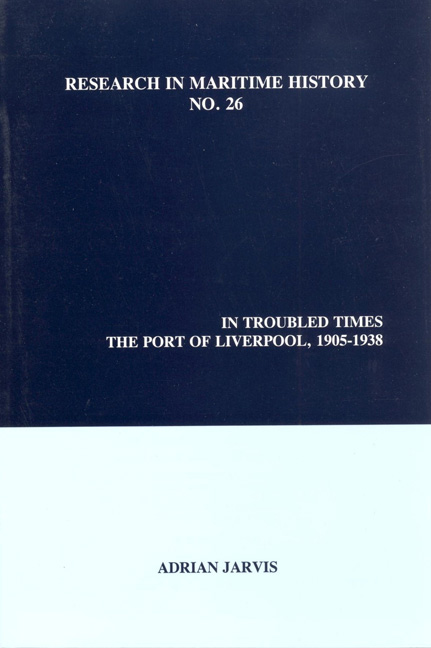Book contents
- Frontmatter
- Table of Contents
- List of Figures
- Foreword and Acknowledgements
- Conversion Factors for Imperial Measurements
- Introduction: The Port of Liverpool in 1905
- Chapter 1 The Port and Its Trade in 1905
- Chapter 2 Gladstone Dock
- Chapter 3 Not Before Time: The Board Keeps its Promise
- Chapter 4 Engineering, Management and Decision-making
- Chapter 5 Making the Customers Happy
- Chapter 6 Sand, Silt and Sewage: The Work of the Board's Dredgers
- Chapter 7 The Provision of Specialist Cargo Facilities
- Chapter 8 Into the Modern World?
- Conclusion: On the Eve of War
- Appendix: Port Efficiency: A Short Methodological Discourse
- A Note on Sources: Abbreviations
- Bibliography
- Index
Chapter 7 - The Provision of Specialist Cargo Facilities
- Frontmatter
- Table of Contents
- List of Figures
- Foreword and Acknowledgements
- Conversion Factors for Imperial Measurements
- Introduction: The Port of Liverpool in 1905
- Chapter 1 The Port and Its Trade in 1905
- Chapter 2 Gladstone Dock
- Chapter 3 Not Before Time: The Board Keeps its Promise
- Chapter 4 Engineering, Management and Decision-making
- Chapter 5 Making the Customers Happy
- Chapter 6 Sand, Silt and Sewage: The Work of the Board's Dredgers
- Chapter 7 The Provision of Specialist Cargo Facilities
- Chapter 8 Into the Modern World?
- Conclusion: On the Eve of War
- Appendix: Port Efficiency: A Short Methodological Discourse
- A Note on Sources: Abbreviations
- Bibliography
- Index
Summary
Background
As a long-term policy, the old Dock Committee and later the Board preferred not to provide specialist facilities, seeking to offer only “highest common factor” quays, sheds and handling equipment which could serve equally well for almost any trade, inward or outward alike. Those wanting special facilities were encouraged to provide them for themselves. This policy, however, was bound to face demands for exceptions, of which perhaps the most obvious early example was the construction of the low quayside at Brunswick (1832) to facilitate the handling of imported timber. Berths at such a quay were usable by other import trades and for export, outside of the (very marked) timber season, but only with some inconvenience, and there were, of course, no transit sheds, so that other cargoes arriving either had to be cleared from the quayside immediately or face the risk of rain damage.
Another form of specialism was exhibited at Albert Dock Warehouses (completed 1846), which were designed to keep high-value and high-duty goods away from the pilferers and smugglers, to provide bonded accommodation and to offer a high degree of fire protection. They were, however, fairly versatile and could handle any form of goods which came in bags, bales, casks or crates. While intended as import warehouses only, provision was made in the structure for hoist doors on the dock side of the warehouses to allow their use for exports with a minimum of alteration.
The first completely single-purpose facility of any size was the high-level railway at Bramley-Moore, designed to load export or bunker coal and opened in 1856. This carried end-tipping railway wagons from the Sandhills depot of the Lancashire and Yorkshire Railway to the water's edge, where special-purpose hydraulic cranes lifted them in a cradle, swung them out over the ship and tipped them. It was quite successful and was considerably extended in 1884. Just when ships were getting too large to use it, the practice of coaling the largest passenger liners out in the river using barges and floating elevators gave it a new lease of life loading the barges, and its final long decline only began when the postwar slump combined with a growing use of oil fuel and intensifying foreign competition in the coal trade to slash the demand for both bunker and export coal.
- Type
- Chapter
- Information
- In Troubled TimesThe Port of Liverpool, 1905-1938, pp. 161 - 186Publisher: Liverpool University PressPrint publication year: 2003



